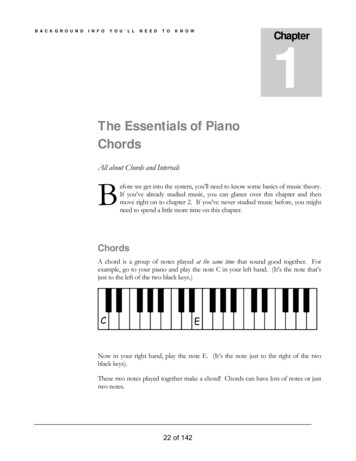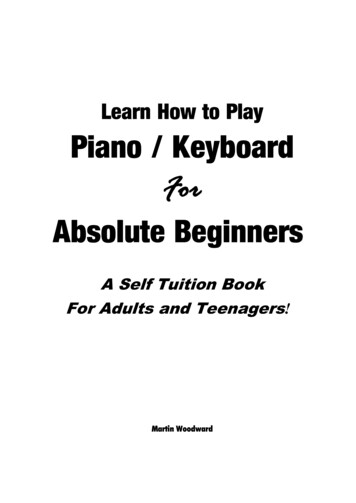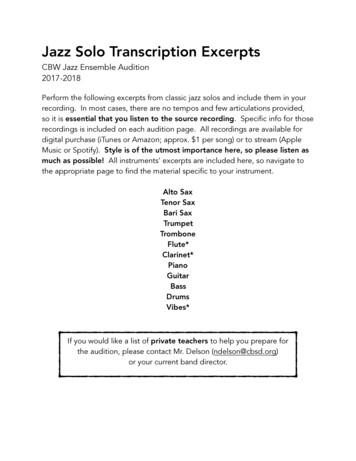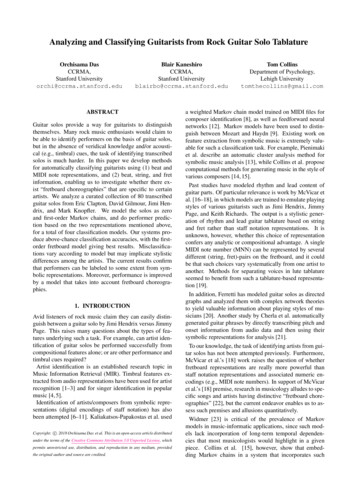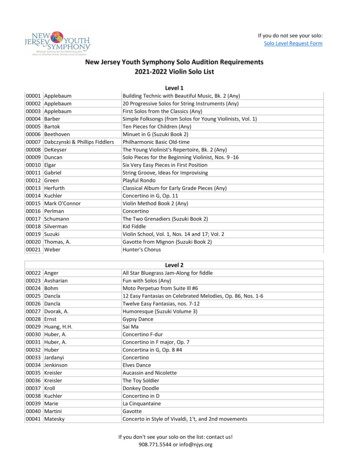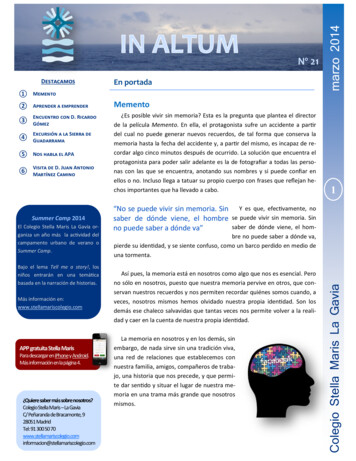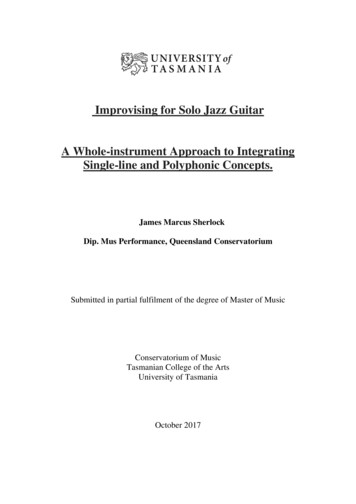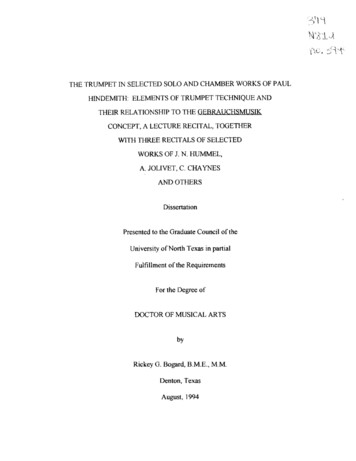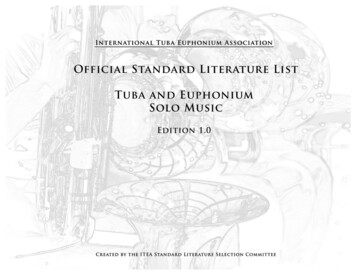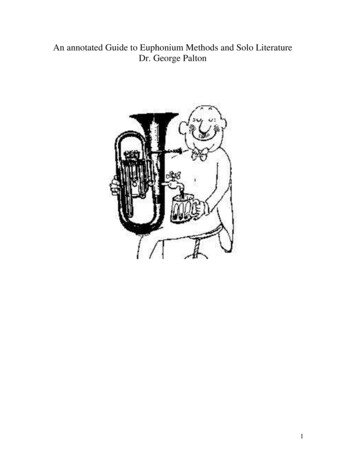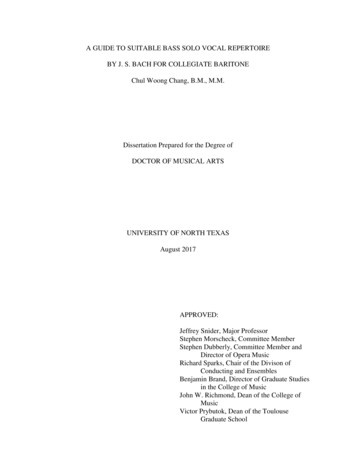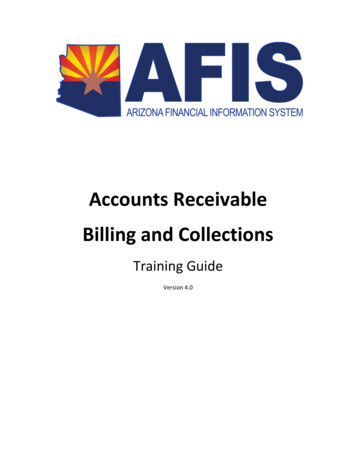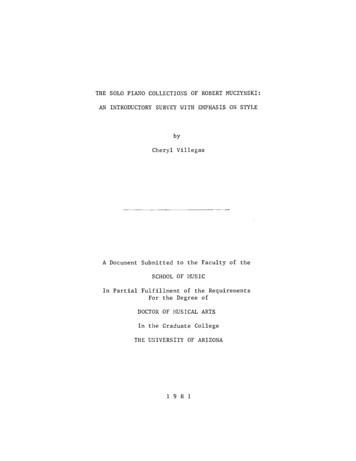
Transcription
THE SOLO PIANO COLLECTIONS OF ROBERT MUCZYNSKI:AN INTRODUCTORY SURVEY WITH EMPHASIS ON STYLEbyCheryl VillegasA Document Submitted to the Faculty of theSCHOOL OF MUSICIn Partial Fulfillment of the RequirementsFor the Degree ofDOCTOR OF MUSICAL ARTSIn the Graduate CollegeTHE UNIVERSITY OF ARIZONA19 81
THE UNIVERSITY OF ARIZONASCHOOL OF MUSICI hereby recommend that this document prepared under mydirection byentitledCheryl VillegasThe Solo Piano Collections of Robert Muczynski:AnIntroductory Survey with Emphasis on Stylebe accepted in partial fulfillment of the requirements for the degreeof Doctor of Musical Arts.nature of Major Pro essorAcceptance for the School of Music:0-7n7«reeJDirector, Graduate Studies in Music
TABLE OF CONTENTSPageLIST OF ILLUSTRATIONSINTRODUCTIONivvCHAPTER1.BIOGRAPHICAL SKETCH OF THE COMPOSER12.STYLE IN THE WORKS OF ROBERT MUCZYNSKI53.GENERAL PERFORMANCE SUGGESTIONS374.PHILOSOPHY OF COMPOSITION AND TEACHING395.CONCLUSIONS AND A LOOK INTO THE FUTURE41SELECTED BIBLIOGRAPHY43DISCOGRAPHY44
LIST OF ILLUSTRATIONSPageFigures1.Sonatina, First movement, measures 1 -1862.Suite, "Festival ", measures 37 -5193.Suite, "Flight ", measures 1 -1610A.Suite, "Vision ", measures 13 -17125.Suite, "Labyrinth ", measures 1 -5136.Suite, "Phantom ", measures 1 -16147.Suite, "Scherzo ", measures 66 -81158.A Summer Journal, "Park Scene ", measures 1 -21189.A Summer Journal, "Midday ", measures 1 -4319 -2010.A Summer Journal, "Birds ", measures 1 -4123 -2411.A Summer Journal, "Solitude ", measures 22 -392512.A Summer Journal, "Night.Rain ", measures 1 -72613.A Summer Journal, "Jubilee ", measures 42 -572714.Fables, No. 7, measures 1 -202815.Fables, No. 9, measures 1 -112916.Maverick Pieces, No. 4, measures 40 -523117.Maverick Pieces, No. 6, measures 1 -103218.Masks, measures 1 -835iv
INTRODUCTIONThe purposes of this study are twofold:to introduce to thepublic the solo piano collections of Robert Muczynski as valid concertand teaching material; and to discuss the style of these pieces inorder to enhance familiarity with the music and insure a more correctperformance.The discussion that follows does not conform to themusic theorist's definition of the term "style ", but is in fact acollection of ideas which a pianist feels will be useful in performingor teaching this music.Thus, this is a general discussion of stylethrough the eyes of a performer and is not meant to be complete.Itis the hope of this author that this introduction to the piano worksof Robert Muczynski will spark an interest in this fine music whichtruly deserves to be better known.The author would like to personally thank Professor RobertMuczynski for unselfishly giving his valuable time and support tothis project.Also many thanks to Professor Richard Faith, whosehelp was invaluable in the preparation of the music to be performed.v
CHAPTER 1BIOGRAPHICAL SKETCH OF THE COMPOSERRobert Muczynski was born in Chicago in 1929.began at the age of five.Piano studiesIn 1947 he enrolled at De Paul Universitywhere he studied piano with Walter Knupfer and composition with thedistinguished composer, Alexander Tcherepnin.lIn 1953, Muczynski was commissioned by the Fromm MusicFoundation to write his First Symphony, "a work which reveals muchdepth and superb training ".2In 1954, he received a commission from the Louisville SymphonyOrchestra which resulted in his First Piano Concerto.The work wasperformed by the composer himself in both the world premiere and ina subsequent historic recording under a grant from the RockefellerFoundation.3Since then he has performed the concerto with theChicago Symphony Orchestra and the Grant Park Summer Symphony(Chicago's annual series of Lake Front Concerts).4In 1958, Professor Muczynski made his New York debut in1Robert Muczynski, Suite, Op. 13, Sonata for Flute and Piano,Op 14, Six Preludes, Op. 6, Sonata No. 1, Op. 9 (Music LibraryRecordings, 6998).2Muczynski, Suite.3Muczynski, Suite.4The Western Arts Trio, Vol. 2 (Laurel Record, LR 106, 1977).1
2Carnegie Hall with a performance of his own works.5well received.The concert wasThe New York Times called him "a skillful pianist andconvincing exponent of his own music ".6aThe journal, MusicalAmerica, labeled him "an exceptionally gifted pianist" whose works"reveal a true sense of the dramatic"6bEarl Wilson's columnannouncing the event added, ".We think the young man is very brave. "7And the Musical Courier described the performance thus:An exceptionally gifted young pianist appeared on thisoccasion in a program of his own compositions, displayingin a somewhat personalized medium of expression technicalskill and a profusion of musical ideas that have not quite"jelled" into an individual style. Mr. Muczynski is alertto interesting patterns and his tonal contrasts are descriptively acute. .All that he writes is pleasant and accentedMuczynski knows how toby a true sense of the dramatic.make the piano sing and backs his instrumental facilitywith cool intelligence.The program listed a Sonatina,Five Sketches, Variations on a Theme of Tcherepnin, SixPreludes, and a Sonata No. 1.8In addition to these achievements, Professor Muczynski hasreceived two Ford Foundation Grants, sixteen consecutive creative-merit awards from ASCAP (American Society of Composers, Authors andPublishers), the International Society for Contemporary Music prizefor the Suite for Piano, and in 1961 the Concours InternationaleSGordonEpperson Plays Cello with Pianist Robert Kuczynski,(Coronet Recording Company, 3000S).6aGordon EpPerson.6bGordonEpperson.7Robert Muczynski, Robert Muczynski (Pamphlet for advertisingpurposes, Cn.d J ), p. 2.8 "New York Concert and Opera Beat ", Musical Courier, Vol. 157,No. 4 (March, 1958), p. 20.
3Award for Composition in Nice, France, for his Sonata for Flute andPiano.9In 1965, his Symphonic Dialogues were performed by the NationalSymphony of Washington, D.C., at the Lincoln. Center's PhilharmonicHall.10In 1977, the Third Piano Sonata was selected as the requiredcontemporary piano work at the Seventh Annual International PianoFestival and Competition at the University of Baltimore in Maryland.Noted contemporary artist David Burge said about this piece:The Third Piano Sonata accomplishes some beautifuland effective things.The first movement is an ingeniousmix of sonata -allegro and variation technique. There area number of sonorous delights, of which the opening statement of the cantabile second theme stands out as particularly haunting.11Also in 1977, Muczynski received the Distinguished AlumniAchievement Award from De Paul University.12To date, Professor Muczynski has had some forty works publishedby G. Schirmer, Inc., Shawnee Press, Associated Music Publishers,Theodore Presser Co., and John Paul Music.In addition, there are alarge number of works still in manuscript including two piano collections, Five Sketches (1952), and the Variations on a Theme of9Leslie Crane Rugg, Music for Flute and Piano by FourAmericans (Laurel -Protone Records, LP -14, 1976).10RobertMuczynski, Letter, Tucson, Arizona (10 January,1981).11Muczynski,12The"Pamphlet", op. cit., p. 3.Arizona Chamber Orchestra, Robert Hull, Conductor(Laurel Record, LR -110, 1978).
4Tcherepnin (1955).13He has also composed the music for ten prize-winning documentary films done in collaboration with the distinguishedcinematographer Harry Atwood.14His music has been recognized by musicians and critics acrossthe country.Winthrop Sargeant of The'New Yorker calls it "originaland outstanding ".15George Anson of Clavier stated that "few Americancomposers of the present day write as well for the keyboard as doesMuczynski ".16And Paul Hume of The Washington Post called him "apolished composer and pianist.Muczynski's writing is skillful,neatly scored and highly expressive.He makes his statements con-vincingly."17His piano music has become increasingly popular while receivingseveral prestigious performances.A number of young American pianistshave performed the sonatas at the National Gallery in Washington, D.C.,Alice Tully Hall and Carnegie Recital Hall in New York City, and atWigmore Hall in London, England.18In 1965, Muczynski joined the faculty at the University ofArizona in Tucson.Currently he is chairman of composition andcomposer -in- residence there.13"RobertMuczynski ", Composers of the Americas, Vol. 9 (1963),pp. 103 ki,18Muczynski,"Pamphlet ", op. cit., p. 3.p.2.p.2.p.2.Letter, op. cit.
CHAPTER 2STYLE IN THE WORKS OF ROBERT MUCZYNSKICurrently there are thirteen published works for solo pianoby Robert Muczynski.A complete list along with dates of compositionare as follows:Sonatina for Piano (1950)Six Preludes for Piano, Op. 6 (1954)Sonata No. 1 for Piano, Op. 9 (1956)Suite for Piano, Op. 13 (1960)Toccata for Piano, Op. 15 (1961)A Summer Journal for Piano, Op. 19 (1964)Fables, Nine Pieces for the Young, for Piano, Op. 21 (1965)Sonata No. 2 for Piano, Op. 22 (1966)Diversions, Nine Pieces for Students, for Piano, Op. 23 (1967)Seven, for Piano Solo, Op. 30 (1971)Sonata No. 3 for Piano, Op. 35 (1974)Maverick Pieces for Piano, Op. 37 (1977)Masks, for Piano, Op. 40 (1980)A discussion of the three Sonatas is beyond the scope of thispaper.The focus will be on the ten remaining collections.The Sonatina for Piano was composed in 1950.earliest published work.It is Muczynski'sThough short, the three movements showseveral elements of Muczynski's developing style.The openingtheme (measures 1 -6) of Figure 1 shows the rhythmic drive associatedwith Muczynski's music.In measure 7 the shift of both hands intothe treble register creates an effective color contrast.The openingtheme returns somewhat varied in measures 11 and 12 only to befollowed again by the contrasting treble register texture in5
6In measure 18-there is yet another color change,in measures 13 -17.this time to the bass register with the low octaves in the left handAlong withand the rhythmic integrity maintained in the right.lively rhythms, dynamic changes and color contrasts, the first eighteenThese elements ofmeasures also contain three meter changes.Muczynski's style will permeate his later works.I/i-tL.eAllegro con spiritor-1pLrIS.wii/4Zv".11. s O1v-,rál:nTlor.-kl.s:,.ì4.:,V:. . .-.,m fIF.Y 1r -. ---.,(PPDINM.01r.,a!1ip.I.-5RiP!., .t. \illIrIr. trs-.11AIIA.i!-- '-f ---e/ / Yl,-s, /s.RÇ. .rel:--iAFigure 1.muroslo.naV--rrY1 Yfy-Isa. 4Z -VO 1MTir C !l NMb .b. 71; Sonatina, First movement, measures 1 -18.N
7The Sonatina is in three movements with the tempo scheme offast -slow -fast.The outer movements are in a miniature sonata allegroform with first and second themes, a short development and full- fledgedrecapitulation.The second movement is a small ABA form with emphasison melodies in groups of four measure phrases.The Six Preludes for Piano, Op. 6, were composed in 1954.The Chicago Daily News described these pieces thus:Muczynski's Preludes struck me as deft sketches, such asa gifted artist might make at a zoo, with a single quickline; each prelude caught the essence of a certaindistinctive piano -sound as the artist might catch the19distinctive (but elusive) cocking of an animal's head.The composer himself makes these comments about the Preludes:I was fresh from the university, and those pieces werea kind of self- imposed exercise.I felt the need totighten up, to make more of my ideas.In earlierpieces I had tended to ramble, to introduce too manyThe Six Preludesthings and not fully develop them.are set in small forms, mostly ABA, and some of themseem to me to have been influenced by the music ofProkofieff, which I greatly admired, partly for itsclarity.I had beenI recall writing No. 6 on New Year's Eve.invited to two parties that evening and had refusedthe second, having already accepted the first. Atthe last moment the first party fell through and Iwas left with nowhere to go, so I sat at the pianoand wrote the last of the Six Preludes. You knowthat Beethoven rondo, Rage Over a Lost Penny? Thisrelentless little toccata is a rage over a lostparty, and probably more fun.20The Preludes contain all the stylistic elements of theSonatina in addition to a commanding sense of lyricism.It is the19Muczynski, "Suite, Sonata, Toccata. ", op. cit.20Muczynski Plays Muczynski (Laurel Record, LR -114, 1980).
8this lyricism which will become more prominent in Muczynski's laterworks.The Suite for Piano, Op. 13, composed in 1960, won a topaward from the International Society for Contemporary Music a yearlater.The piece consists of six movements.Descriptive titleswere "selected for the purpose of identification and were suggestedby the contents of the pieces ".21In the Suite, the composer experimented with new compositionaltechniques and different creative ideas, resulting in six highlycontrasting movements.On paper, the Suite looks different from theprevious compositions.The sound is also much different, perhapssuggesting a more mature style.The first piece, "Festival ", is described as a boisterousmarch -like movement "with strongly accented syncopated rhythmsdemanding articulate passage playing ".2221RobertMuczynski, Suite for Piano, Op. 13, performed byPaulina Drake (Orion Master Recordings, ORS 75168).22 "RobertSuite for Piano, Op. 13 ", Music LibraryMuczynski:Association Notes, Vol. 20, No. 4 (1963), p. 581.
6aa.znSt3--o''g 'aint .-a -4Tentsa3 « vupr-tosainseam IS-L uI a.znSt,I z anoqe aoilou aul TEatzlaunuXse SuidnozS jo salouut aznseampueq 1ZedL uI saanseam 8 pue 6 uI sainseam 07 pus T7sdno.z3 Jo oM2 ajtgMa.zaua szaTotmaq ui aql 3q3tsaql 1112ta puEq sain3i3 'TR.; olutaql 13aT pUeq suTemal uiaaaqi
10Meanwhile the meter signature is frequently changing and in theThe 51st47th measure, the signature 16 appears for the first time.measure contains a cluster chord.In the second movement, "Flight ", an "undulating tripletfigure transfers the broken chords from right to left ha
1Robert Muczynski, Suite, Op. 13, Sonata for Flute and Piano, Op 14, Six Preludes, Op. 6, Sonata No. 1, Op. 9 (Music Library Recordings, 6998). 2Muczynski, Suite. 3Muczynski, Suite. 4The Western Arts Trio, Vol. 2 (Laurel Record, LR 106, 1977). 1. 2 Carnegie Hall with a performance of his own works.5 The concert was well received. The New York Times called him "a skillful pianist and convincing .
